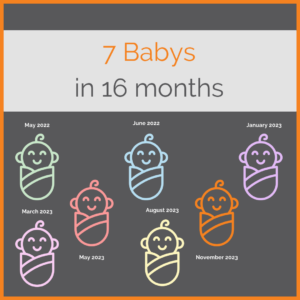
tracekey is not a big company, but with its number of employees clearly belongs to the SMEs. Many staff absences at once can therefore have a much more noticeable impact than in larger companies. And yet our managing directors and everyone else managed to stay completely relaxed when “We’re having a baby” suddenly became a standard phrase. How did tracekey cope with the internal baby boom? Were there major hurdles that had to be overcome, or did everything just fall into place? In this article, we’ll address one big topic: babies at tracekey.
tracekey has around 30 employees. Seven of them had a baby within just 16 months. Our managers received the first of the announcements in November 2021. The second one followed shortly before Christmas, and so it went on. After the third “I need to have a word with you,” our management knew the score. “We’re having a baby in May/June 2022/January/March/June/August/October 2023” became a much-said phrase. There has been a so-called baby boom across all departments. Developers, Customer Success employees, people from Marketing, Scrum Team, or IT Operations – in almost every team we have people with a new family member. Now and then, they are also very present. It’s pretty common to spot adorable baby pictures being shared in chats, the baby itself is showcased at work events, or even have a little one visit the office with their parent. Let’s face it, we’ve all seen a sleepy baby on camera when their parent has to juggle a meeting and parenting duties.
Challenges: What is the baby boom doing to teams?
A total of more than 70 months of parental leave plus a few months of maternity leave – if you extrapolate. So many babies within that short period eliminates some staffing resources. But the colleagues were always happy for the new parent, and everyone worked together to fill in for the missing people. Of course, this wasn´t possible for all projects equally and happened “just like that”. For this reason, some projects were reprioritized, and some tasks were simply put on hold. In this way, the focus of individual persons could also be mapped.
Stefan Hoffmann: “Some things are not standardized in small companies. They happen so rarely that you look at each one on a case-by-case basis. With so many people who had to deal with parental leave applications, temporary off-boarding, etc., at the same time, we needed a fixed process to map all the important steps and not forget anything. Once we had that, things went smoothly again straight away.”
What has changed?
Of course, the longer absence due to parental leave had to be compensated for. Our two significant advantages here: unlike sudden absences due to illness, planned parental leave usually has quite a long lead time. Therefore, it was possible to replace the missing resources in different ways:
– New people were hired to provide the teams with sufficient human resources.
– Our agile way of working made it possible for us to plan projects and tasks in a way that fit the capabilities of the individual teams.
– The affected teams were reorganized, structures were adjusted accordingly, and tasks were reallocated. Gerald Wenzel: “A company lives with and from the people who work in it. It has to be set up in such a way, that even longer absences, for example, due to illness, can be compensated. That’s why all the parental leave was not an unsolvable task for us.”
Stefan Hoffmann: “Of course, we are always developing. In the first few years after the company was founded, hardly anyone worked part-time. Now, over 50% of employees work less than 40 hours per week.” The people who have chosen a part-time model do not all work this way because they are parents. A few have other activities or projects alongside tracekey or are striving for a better work-life balance. Stefan Hoffmann: “Flexitime, agility, good teamwork – all this means that we can offer flexible working time models in many places that suit our employees, but also the requirements in the company.”
What have we learned from this?
Our company is well positioned. We have many motivated people who work together to keep tracekey moving forward. The organization within the company is also constantly changing. The agile structures allow us to manage this well.
We always try to make the knowledge within a team accessible to everyone. That means tickets are regularly maintained, and instructions, workflows, and FAQs are available on our intranet. This also benefited us when training new employees in recent months. They could acquire a large part of their knowledge themselves and quickly take on tasks independently.
Our general learning consists of a confirmation: Our agile structures and corporate culture are paying off. Where experts work together and are motivated to achieve a vision, it is not the number of employees that counts. It’s the way they work together that makes the difference.
If you want to learn more about our company these links might interest you:
- tracekey as an agile company
- 10th anniversary of tracekey
- tracekey is growing
- Digital Teamwork: How We Work With Our Customers and Internally